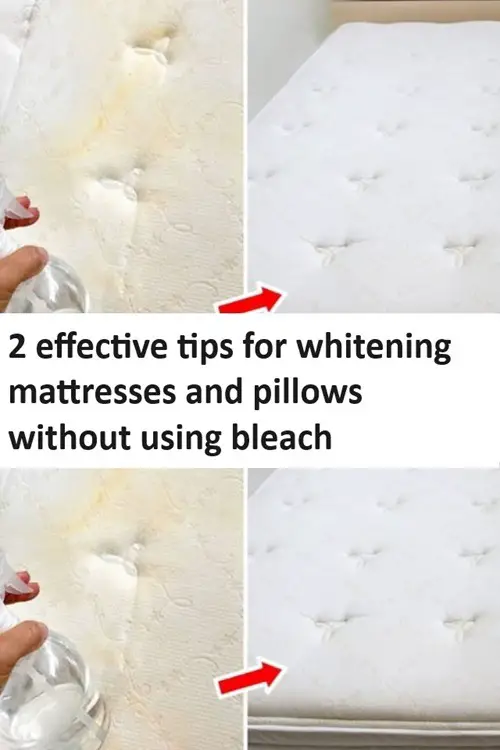Maintaining the cleanliness and whiteness of mattresses and pillows is essential for a healthy sleeping environment. Over time, these items can accumulate stains from sweat, oils, and other bodily fluids, leading to discoloration. While bleach is a common whitening agent, it can be harsh and may degrade fabrics. Fortunately, there are effective, natural alternatives to restore the brightness of your bedding without resorting to bleach.
Whitening Pillows Naturally
Materials Needed:
- 3 liters of water
- 100 ml of hydrogen peroxide
- Juice of 5 lemons
- 200 ml of liquid laundry detergent
- 50 ml of organic dishwashing liquid
- 125 g of borax
Procedure:
- Prepare the Whitening Solution:
- In a large container, combine 3 liters of water with 100 ml of hydrogen peroxide and the juice of 5 lemons. Stir the mixture thoroughly and set it aside.
- Check Pillow Care Instructions:
- Before proceeding, examine the care label on your pillows to ensure they are machine washable. Most synthetic and down pillows are suitable for machine washing, but it’s essential to confirm to prevent damage.
- Load the Washing Machine:
- Place the pillows into the washing machine. To maintain balance during the spin cycle, it’s advisable to wash two pillows simultaneously.
- Add Cleaning Agents:
- Directly into the drum of the washing machine, add 200 ml of liquid laundry detergent, 50 ml of organic dishwashing liquid, and 125 g of borax. These agents work together to break down stains and oils effectively.
- Initiate the Wash Cycle:
- Select a hot water wash cycle, as hot water enhances the cleaning power of the detergents and helps to sanitize the pillows. Start the cycle, allowing the cleaning agents to mix thoroughly before the water fills up.
- Add the Whitening Solution:
- Once the washing machine has filled with water and the initial agitation has begun, pour the previously prepared hydrogen peroxide and lemon juice solution into the fabric softener dispenser. If your machine doesn’t have a dispenser, you can add the solution directly into the drum after pausing the cycle.
- Complete the Wash:
- Allow the washing machine to complete the full cycle, including a thorough rinse to remove any residual cleaning agents.
- Dry the Pillows:
- After washing, it’s crucial to dry the pillows thoroughly to prevent mold and mildew growth. Place them in the dryer on a low heat setting. Adding a couple of clean tennis balls or dryer balls can help fluff the pillows and maintain their shape during drying.
This method leverages the natural bleaching properties of lemon juice and hydrogen peroxide, combined with the cleaning power of borax and detergents, to whiten pillows effectively without the harshness of chlorine bleach.
Cleaning and Whitening Mattresses
Materials Needed:
- Baking soda
- Hydrogen peroxide
- Liquid dish soap
- Spray bottle
- Vacuum cleaner with upholstery attachment
Procedure:
- Vacuum the Mattress:
- Begin by thoroughly vacuuming the mattress surface using the upholstery attachment. This step removes dust, dead skin cells, and other debris, preparing the mattress for cleaning.
- Spot Cleaning Stains:
- In a spray bottle, mix 10 ounces of hydrogen peroxide with 3 tablespoons of baking soda and a few drops of liquid dish soap. Shake the bottle gently to combine the ingredients.
- Lightly spray the stained areas of the mattress with the solution. Be cautious not to oversaturate the mattress, as excessive moisture can lead to mold growth.
- Allow the solution to sit on the stains for about 10 minutes. The bubbling action helps lift stains from the fabric.
- Gently blot the area with a clean cloth to absorb excess moisture and lifted stains.
- Deodorizing and Overall Whitening:
- Evenly sprinkle a generous layer of baking soda over the entire mattress surface. Baking soda acts as a natural deodorizer and mild abrasive, aiding in the whitening process.
- Let the baking soda sit for several hours, or ideally overnight, to absorb odors and moisture.
- Final Vacuuming:
- After the baking soda has had ample time to work, vacuum the mattress thoroughly to remove all residue.
- Drying:
- Ensure the mattress is completely dry before remaking the bed. You can expedite drying by pointing a fan at the mattress or opening windows to increase air circulation.
Regular maintenance of your mattress and pillows not only enhances their appearance but also contributes to a healthier sleeping environment. By utilizing these natural cleaning methods, you can effectively whiten and refresh your bedding without the use of harsh chemicals.
For a visual demonstration of pillow whitening techniques, you might find this video helpful:

